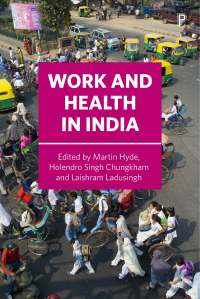Martin Hyde, co-editor of Work and health in India, discusses the relationship between work and health in a country with one of the fastest growing economies in the world and with a labour force of nearly half a billion people.
Work stress and its effect on our health is something that we hear a lot about in the UK. Working longer and longer hours, having to do more and more in less and less time, increasing job insecurity are things that many of us experience. Newspapers and internet sites are full of stories about the damage that this can do to our overall sense of well-being as well as remedies to counter these negative effects. Many of these are supported by decades worth of academic research on the relationship between the working environment and health.
However, once we go beyond the high-income countries of Europe, North America and Japan we know very little about the nature of work and its impact on health in lower and middle-income countries. Given that these countries contain some of the world’s largest workforces and fastest growing economies this is a major oversight.
It was the desire to correct this oversight that motivated us to put together this book on the relationship between work and heath in India. Whilst there had been some research on this topic in India this book is one of the first to address the topic of work environment, stress and health in a rapidly developing country.
“The benefits of India’s tremendous economic growth have been unevenly distributed across society.”
India is one of the fastest growing economies in the world. The growth of the Indian economy has been matched by the steady increase in its labour force, which has risen from 330 million in 1990 to nearly half a billion people in 2014. This is roughly double the size of the labour force of the entire European Union.
Not only has the workforce grown but it has also changed from one dominated by agriculture to one with vibrant and growing service and manufacturing sectors. However, the benefits of India’s tremendous economic growth have been unevenly distributed across society.
The same is true of developments in the health of the Indian population. Life expectancy has risen steadily for both sexes and infectious diseases have declined over the past few decades. However, this fall in infectious diseases has been accompanied by a rise in non-communicable diseases (NCD), which now account for the top three causes of death in India.
“Chronic psychosocial stress at work is now becoming an important threat to the health of employees.”
So not only is the Indian economy and workforce beginning to more closely resemble those of the advanced industrial economies, so too are its disease and mortality profiles. As the labour market underwent a substantial transformation and while some traditional occupational hazards disappeared, chronic psychosocial stress at work is now becoming an important threat to the health of employees. For us, these twin developments called for more research to look at these issues.
To start to do so this book brings together a multidisciplinary and multinational authorship with researchers from all across India, from all careers stages, as well as researchers from the UK and Sweden. The range of topics covered, and methods and data used throughout the book reflect the diverse nature of the Indian economy.
Some chapters, such as those by Sanjay K. Mohanty and Anshul Kastor, and Harihar Sahoo, draw on large scale surveys to map the national picture of occupational inequalities in health. Other chapters focus on specific occupational groups such as tea pickers (Subrata K. Roy and Tanaya Kundu Chowdhury), police officers (Vaijayanthee Kumar and T.J. Kamalanabhan) and scavengers (Vimal Kumar).
What comes out in all of these chapters is a complex picture of the relationship between work and health. On the one hand we see many of the same issues in India that we see in other countries. Work stress is bad for your health wherever you live. On the other hand there are some findings that appear contradictory. For example, those in the highest occupations seem to have the highest rate of diagnosed illness. However, this is probably because only those in the top jobs can afford to go to a doctor. Finally, underlying all of this we see the intersections between gender, class and caste that impact on both work and health.
 Work and health in India edited by Martin Hyde, Holendro Singh Chungkham and Laishram Ladusingh is available with 20% discount on the Policy Press website. Order here for just £60.00, or as an ebook for £21.59.
Work and health in India edited by Martin Hyde, Holendro Singh Chungkham and Laishram Ladusingh is available with 20% discount on the Policy Press website. Order here for just £60.00, or as an ebook for £21.59.
Find out more about impact, influence and engagement at Policy Press here.
Policy Press newsletter subscribers receive a 35% discount – sign up here.
The views and opinions expressed on this blog site are solely those of the original blog post authors and other contributors. These views and opinions do not necessarily represent those of the Policy Press and/or any/all contributors to this site.


0 Responses to “The relationship between work & health in India”